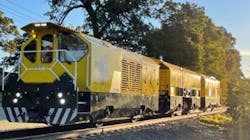Future Rail Treatment - NOW
What is the significance of the rail for wheel-rail system behavior?
The rail is a central component of the wheel-rail system, as it defines the wheel-rail contact patch together with the wheel. Although the rail sits at a central point of the system, it cannot be classified as the most important component. Every component of the system (subgrade, ballast, ties, fastenings, etc.) has an impact on system behavior and thus has a direct or indirect impact on the other components of the system, as well. Only by choosing a holistic approach that considers these components and their interactions, the whole system can be optimized.
What can be done to extend the life of the rail (and the system)?
The term “rail treatment” is used to summarize strategies, measures, and technologies to extend the life of the rail and the system. The infrastructure owner can choose from several tools in the rail treatment toolbox, so to speak. First, measurement technology is a requirement, or even a precondition, for using any other tool, as you can only manage what you can measure. Measurement technology includes transversal and longitudinal profile measurement, surface crack detection systems, and ultrasound systems.
Next, the most suitable rail grade needs to be selected for the application scenario in question and these rail grades need to be joined with a reliable, high-quality joining technology, such as flash butt welding, so that the rail and rail connection have the same service life. Optimized rail (and wheel profiles) reduce contact stresses and improve vehicle steering, thereby extending the life of both components. A track in very good condition has low dynamic forces, which delays the formation of rail damage. Conversely, a damage free rail in very good condition delays track degradation. Friction management, the combined application of gauge face lubrication and top of rail friction control, reduces contact and steering forces between the wheel and rail, which delays the formation of rail damage.
Finally, rail maintenance (rail grinding, rail milling) is the only tool in the toolbox that does not delay the formation of damage. Instead, it can counter rail degradation by removing surface damage and restoring the rail profile. It is important to highlight that these rail treatment tools must not be seen as stand-alone solutions; instead, they need to be applied considering their direct or indirect interaction.
Rail grinding and rail milling – competitive or complimentary technologies?
Rail grinding and rail milling are the two main technologies for rail maintenance. Rail grinding is an abrasive process that allows for low to medium metal removal per machine pass, creating the desired rail profile as a slightly polygonised shape. The process allows for “on the fly” profile adaptation by adjusting the grinding stone angle and pressure. The bi-directional process results in sparks and dust that can be adequately controlled through various measures (spark shielding, fire-suppression equipment, a dust collection system). The resultant surface quality (roughness) can be adjusted through the process parameters. Rail grinding machines are available in various sizes, ranging from a small eight8-stone high-rail vehicle to a 120-stone production grinder. Rail grinding can achieve passing speeds of up to 20 mph.
Rail milling is a dry, spark- and dust-free, rotational cutting process in which the rail material is removed from the rail surface in the form of milling chips. The chips are collected and stored on the machine for later recycling. The resultant rail profile is defined by the negative shape of the cutting head. A different profile requires changing the cutter head. Rail milling has a wide range of metal removal capabilities, ranging from 0.3 mm to several millimeters per pass, depending on the machine size. Due to the integrated polishing process, rail milling creates a high-quality surface finish with low roughness. The directional process can achieve up to 1.85 mph per pass.
Considering the properties of both technologies, it is evident that grinding and milling are mostly complimentary technologies. Rail grinding has the highest productivity in preventive, low metal removal scenarios, whereas rail milling has the advantage in regenerative or heavy corrective scenarios that require high metal removal. There is a limited competitive overlap in corrective applications requiring medium to high metal removal. Of course, specific customer requirements and technological properties may shift the application window toward one maintenance technology or the other.
What is the future of rail treatment?
The future of rail treatment has already begun today, with Plasser American offering a wide variety of innovative technologies and services as a full-service provider in the areas of rail measurement technology, rail welding, and rail maintenance, as well as track maintenance machinery / technologies.
-----------------------------
Richard Stock is global head of rail solutions at Plasser American.



